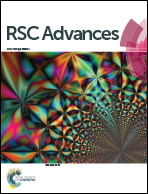Preparation and evaluation of PCL–PEG–PCL polymeric nanoparticles for doxorubicin delivery against breast cancer
Abstract
Doxorubicin (DOX), an anthracycline anticancer drug, was successfully incorporated into polymeric nanoparticles (NPs) based on poly(ε-caprolactone)–poly(ethylene glycol)–poly(ε-caprolactone) (PCL–PEG–PCL) amphiphilic triblock copolymers by thin-film hydration and an ultrasonic dispersion method. The prepared DOX-loaded polymeric NPs showed spherical shapes with an apparent core–shell morphology. The average particle size of the DOX-loaded NPs was 130.8 nm with a narrow size distribution (PDI = 0.200). DOX was entrapped in the polymeric NPs with an encapsulation efficiency and loading content of 86.71 ± 2.05% and 8.72 ± 0.57%, respectively. DOX-release from the NPs was by a sustained and long-term fashion up to several weeks, and achieved faster release at pH 5.5 than that at pH 7.0. An in vitro cytotoxicity assay against EMT6 cells demonstrated that the cytotoxic effect of DOX-loaded NPs gradually approached that of free DOX when increasing the concentration and the incubation time. Confocal laser scanning microscopy results showed that the DOX fluorescence was distributed both in the cytoplasm and nucleus for DOX-loaded NPs treated cells, while the red fluorescence was observed mostly in the nucleus for free DOX treated cells. A cell analyzer was used to further quantitatively analyze the intracellular distribution of DOX-loaded NPs on a cell-by-cell basis, indicating that DOX fluorescence in the nucleus was lower than that in the cytoplasm for 1 h incubation, but higher than that in the cytoplasm for long-time incubation (4 h and 24 h). Furthermore, ex vivo DOX fluorescence imaging revealed that DOX-loaded NPs had highly efficient targeting and accumulation at the implanted site of an EMT6 xenograft tumor in vivo through an enhanced permeation and retention mechanism. These results suggest that the DOX-loaded polymeric NPs based on the PCL–PEG–PCL triblock copolymer would be a promising nanosized drug delivery system for cancer therapy.



 Please wait while we load your content...
Please wait while we load your content...